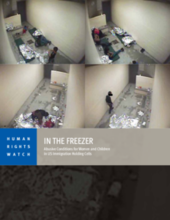Summary
United States immigration authorities routinely detain men, women, and children, including infants, in frigid holding cells, sometimes for days, when they are taken into custody at or near the US border with Mexico. Migrants and US Customs and Border Protection (CBP) agents alike commonly refer to these cells as hieleras (“freezers”).
All immigration detainees have the right to be treated with dignity and humanity, and children, whether unaccompanied or with family members, are entitled to additional safeguards under US and international law. This report examines US authorities’ compliance with the specific protections that should be afforded to children, drawing on 110 interviews with children themselves or women detained with their children. As detailed below, we found that conditions in holding cells at the southern border are often poor and in several critical respects identical to those previously found by US courts to be in violation of CBP’s obligations and prior commitments.
Women and children detained along the border usually spend one to three nights, and sometimes longer, in CBP holding cells, where they sleep on the floor, often with only a Mylar blanket, similar to the foil wrappers used by marathon runners, to protect them from the cold. Border agents sometimes require them to remove and discard sweaters or other layers of clothing, purportedly for security reasons, before they enter the holding cells.
Almost all of the women and children we spoke with said that they were not allowed to shower, sometimes for days, until just before they were transferred to longer-term detention facilities. Nearly all said that they did not receive hand soap, toothpaste, or toothbrushes in these holding cells, meaning that for the duration of their stay they were not able to wash their hands with soap before and after eating and after using the toilet. Most women said that menstrual hygiene products and diapers were available on request, but several told us they did not have access to these items while in CBP holding cells. If they had these and other toiletries among their personal property, they were not allowed to retrieve these items while in the holding cells.
In a typical account, Carolina R., a Guatemalan woman who spent four nights in a freezer in Arizona in late August 2017, told Human Rights Watch, “It was cold, really cold. They just gave us a piece of aluminium for a blanket [likely a Mylar blanket]. There weren’t any mats. We just slept on the floor.” The women and children held in the cell could not shower during the four days she was there, she said.
Investigations by other groups have also found that holding cells are uncomfortably cold. In October 2017, for example, the Women’s Refugee Commission reported that nearly all of some 150 women interviewed in 2016 and 2017 said they had been held “for days in freezing cold CBP facilities.”
While some agents refer to holding cells as hieleras, CBP officials publicly deny that these holding cells are cold. Human Rights Watch was not able to determine the precise temperature in any of the holding facilities, but women and children detained in CBP holding cells and other immigration detention facilities consistently report that the temperatures in the holding cells are uncomfortably cold.
Immigration holding cells often do not provide sleeping mats even though it is common for women and children to spend at least one night in these facilities. Nearly all of the women and children interviewed by Human Rights Watch spent at least one night in a CBP holding cell. Other studies, including one by the US Government Accountability Office (GAO), have consistently found that two-thirds of migrants in holding cells remain there for at least one night, and tens of thousands of migrants spend 72 hours or more in holding cells.
CBP acknowledges that it does not routinely provide sleeping mats but has attempted to justify its failure to do so by stating that its holding cells are not designed for overnight custody. Even so, it revised its detention standards in 2015 to state that detention in holding cells should “generally” last no longer than 72 hours.
Immigration authorities hold adult men, teenage boys and girls, and mothers and younger children in separate cells, meaning that families are often separated when they are placed in CBP holding cells.
Detention and family separation, even for short periods of time, have serious adverse consequences for mental well-being, particularly for those who have already suffered trauma. Most of the women and children interviewed by Human Rights Watch said they had fled their home countries after they were targeted for violence or other persecution, and many had faced abuse on their journey.
Time in CBP holding cells was “the most difficult and traumatic” period of detention for women and children apprehended by US immigration authorities, a 2015 mental health assessment found.
To address these serious concerns, holding cells should be used for very short periods of confinement only. As CBP itself states, these facilities are not designed for overnight stays, and a detention expert who examined these cells concluded that they were not appropriate for confinement of adults for more than 10 hours. Detention overnight in holding cells should accordingly be employed only when it is unavoidable, and never for children. Those who are held overnight should receive sleeping mats as well as blankets. Temperatures in holding cells should be set at reasonable and comfortable levels. Access to showers and hygiene materials, including soap, toothbrushes, and menstrual hygiene products, should be provided to those held overnight.
US immigration authorities should also avoid splitting families upon apprehension. Instead, authorities should identify and implement alternatives to detention that keep families together.

